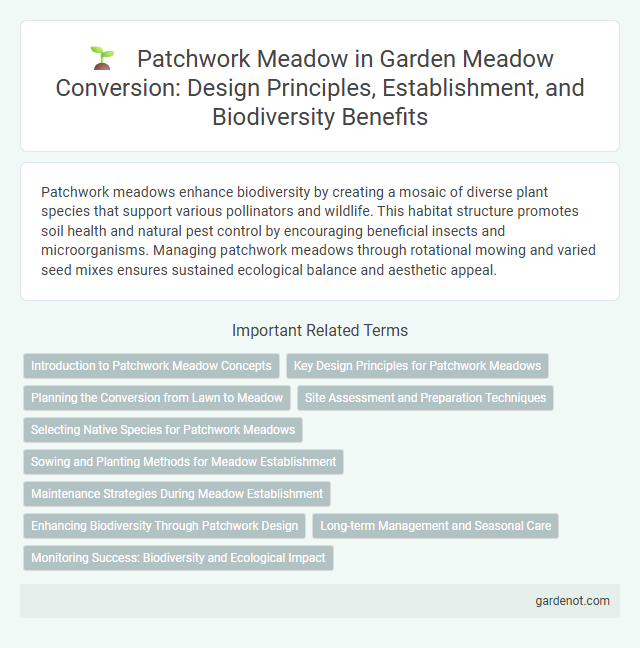Patchwork meadows enhance biodiversity by creating a mosaic of diverse plant species that support various pollinators and wildlife. This habitat structure promotes soil health and natural pest control by encouraging beneficial insects and microorganisms. Managing patchwork meadows through rotational mowing and varied seed mixes ensures sustained ecological balance and aesthetic appeal.
Introduction to Patchwork Meadow Concepts
Patchwork meadow is a sustainable land management approach that combines diverse plant species in segmented plots to enhance biodiversity and soil health. This technique mimics natural ecosystems by integrating wildflowers, grasses, and legumes, promoting pollinator habitats and improving ecosystem resilience. Implementing patchwork meadow concepts supports carbon sequestration, reduces erosion, and contributes to climate change mitigation.
Key Design Principles for Patchwork Meadows
Patchwork meadows are designed using key principles such as diverse plant species selection to enhance biodiversity and support pollinators, spatial variation in sward height to create microhabitats, and rotational mowing regimes to maintain structural diversity and prevent dominance of aggressive species. Incorporating native wildflowers and grasses adapted to local soil conditions promotes ecosystem resilience and encourages natural regeneration. Strategic placement of hedgerows and buffer strips enhances connectivity between habitats, supporting wildlife movement and nutrient cycling within agricultural landscapes.
Planning the Conversion from Lawn to Meadow
Planning the conversion from lawn to a patchwork meadow involves selecting native wildflowers and grasses suited to the local climate and soil conditions to ensure ecological balance and biodiversity. Preparing the soil by reducing nutrient levels through mowing and raking promotes the establishment of wild species over aggressive lawn grasses. Incorporating diverse seed mixes and scheduling sowing during optimal seasons enhances germination rates and supports pollinators such as bees and butterflies.
Site Assessment and Preparation Techniques
Site assessment for patchwork meadow conversion involves evaluating soil health, drainage patterns, and existing vegetation to ensure optimal plant growth. Preparation techniques include soil aeration, removal of invasive species, and targeted nutrient amendments to create a conducive environment for native wildflowers and grasses. Detailed mapping of microhabitats guides seed selection and planting strategies for maximum biodiversity.
Selecting Native Species for Patchwork Meadows
Selecting native species for patchwork meadows enhances local biodiversity by providing habitat tailored to regional wildlife. Incorporate a diverse palette of grasses, wildflowers, and legumes native to the area to ensure resilience and adaptability to soil and climate conditions. Prioritize species with staggered bloom times and structural variety to support pollinators and soil health throughout the growing season.
Sowing and Planting Methods for Meadow Establishment
Patchwork meadow establishment involves precise sowing and planting methods tailored to promote biodiversity and resilience. Techniques include direct seeding of native wildflower mixes combined with plug planting of grass species to ensure rapid ground cover and habitat complexity. Optimal timing during early autumn or spring maximizes germination rates and supports the integration of diverse plant communities essential for patchwork meadow success.
Maintenance Strategies During Meadow Establishment
Patchwork meadow maintenance during establishment involves regular monitoring to ensure seedling survival and optimal growth. Strategic mowing at specific heights promotes biodiversity by suppressing competitive grasses while encouraging wildflower development. Periodic removal of cut material prevents nutrient buildup, maintaining soil conditions favorable for diverse plant species.
Enhancing Biodiversity Through Patchwork Design
Patchwork meadow design significantly enhances biodiversity by creating a mosaic of diverse habitats that support a wide range of flora and fauna. This approach incorporates varied plant species and structural layers, fostering pollinators, birds, and beneficial insects essential for ecosystem balance. Implementing patchwork meadows boosts soil health and resilience against environmental stressors, promoting sustainable meadow conversion.
Long-term Management and Seasonal Care
Patchwork meadow long-term management involves regular mowing and selective grazing to maintain biodiversity and prevent scrub encroachment. Seasonal care includes timely cutting in late summer to promote wildflower regeneration and staggered removal of clippings to preserve soil nutrients. Consistent monitoring of species composition ensures a dynamic habitat supporting pollinators and native wildlife.
Monitoring Success: Biodiversity and Ecological Impact
Patchwork meadow conversion supports diverse habitats by increasing plant species richness and promoting pollinators like bees and butterflies, enhancing overall biodiversity. Monitoring success involves regular surveys of flora and fauna, tracking soil health parameters, and assessing ecosystem services such as carbon sequestration and water retention. Long-term ecological impact is measured through improved habitat connectivity and resilience against environmental stressors.
Patchwork meadow Infographic

 gardenot.com
gardenot.com